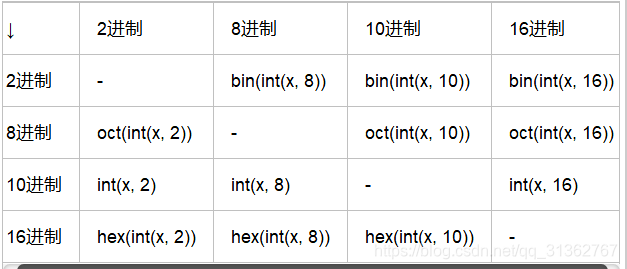python 中的进制转换 整理
本文共 3144 字,大约阅读时间需要 10 分钟。
工作中经常需要用到进制转换, 一直对这方面有一些模糊, 终于有时间把这方面整理一下了.
常用的进制: 二进制bin(), 八进制oct(), 十进制int(), 十六进制hex() 下面我采用python3.6中的源码进行解释, 来自python中的builtins.pybin(x) 将一个整型数字转换为二进制字符串
def bin(*args, **kwargs): # NOTE: unreliably restored from __doc__ """ Return the binary representation of an integer. >>> bin(2796202) '0b1010101010101010101010' """ pass
oct() 将一个整型数字转换为一个八进制字符串
def oct(*args, **kwargs): # real signature unknown; NOTE: unreliably restored from __doc__ """ Return the octal representation of an integer. >>> oct(342391) '0o1234567' """ pass
int() 将一个数字或者字符串转换为一个整型数字
def __init__(self, x, base=10): # known special case of int.__init__ """ int(x=0) -> integer int(x, base=10) -> integer Convert a number or string to an integer, or return 0 if no arguments are given. If x is a number, return x.__int__(). For floating point numbers, this truncates towards zero. If x is not a number or if base is given, then x must be a string, bytes, or bytearray instance representing an integer literal in the given base. The literal can be preceded by '+' or '-' and be surrounded by whitespace. The base defaults to 10. Valid bases are 0 and 2-36. Base 0 means to interpret the base from the string as an integer literal. >>> int('0b100', base=0) 4 # (copied from class doc) """ pass hex() 将一个整型数字转换为一个十六进制字符串
def hex(*args, **kwargs): # NOTE: unreliably restored from __doc__ """ Return the hexadecimal representation of an integer. >>> hex(12648430) '0xc0ffee' """ pass
下面是一个不同进制之间的相互转换:
>>> bin(15)'0b1111'>>> bin(2)'0b10'
>>> oct(16)'0o20'>>> oct(64)'0o100'
>>> hex(16)'0x10'>>> hex(256)'0x100'
实际工作中我们可能需要自己写进制转换, 因为自带的返回值含有前缀;
import os, sysbaseNumDict = ['0', '1', '2', '3', '4', '5', '6', '7', '8', '9', 'A', 'B', 'C', 'D', 'E', 'F'] # baseNumDict = [str(x) for x in range(10)] + [chr(x) for x in range(ord('A'), ord("F")) ] # 二进制转为 十进制def bin2dec(strNum): return str(int(strNum,2))print(bin2dec("11")) # 3# 八进制转为十进制def oct2dec(strNum): return str(int(strNum,8))print(oct2dec('11')) # 9# 十六进制转为十进制def hex2dec(strNum): return str(int(strNum,16))print(hex2dec('11')) # 17 # 十进制转为二进制def dec2bin(num: int): if num == 0: return 0 elif num < 0: return "please input a positive num" bitList = [] while num != 0: num, res = divmod(num,2) bitList.append(baseNumDict.get(res)) return ''.join([str(i) for i in bitList][::-1])print(dec2bin("15"))# 八进制 和 十六进制转二进制, 可以采用先转为十进制, 后再转为二进制 # 同理:# 十进制转为八进制def dec2oct(num: int): if num == 0: return 0 elif num < 0: return "please input a positive num" bitList = [] while num != 0: num, res = divmod(num, 8) bitList.append(baseNumDict[res]) return ''.join([str(i) for i in bitList][::-1])print(dec2oct("16"))# 十进制转为十六进制, 只要将上面代码中的 divmod(num,8) 改为 divmod(num,16) 进制转换, 如果直接转一次不能完成的话, 那就先转成其他进制, 间接地转.
参考博客: https://www.cnblogs.com/jsplyy/p/5636246.html
你可能感兴趣的文章
Netty工作笔记0081---编解码器和处理器链梳理
查看>>
Netty工作笔记0084---通过自定义协议解决粘包拆包问题2
查看>>
Netty工作笔记0085---TCP粘包拆包内容梳理
查看>>
Netty常用组件一
查看>>
Netty常见组件二
查看>>
netty底层源码探究:启动流程;EventLoop中的selector、线程、任务队列;监听处理accept、read事件流程;
查看>>
Netty心跳检测
查看>>
Netty心跳检测机制
查看>>
netty既做服务端又做客户端_网易新闻客户端广告怎么做
查看>>
Netty核心模块组件
查看>>
Netty框架内的宝藏:ByteBuf
查看>>
Netty框架的服务端开发中创建EventLoopGroup对象时线程数量源码解析
查看>>
Netty源码—1.服务端启动流程一
查看>>
Netty源码—1.服务端启动流程二
查看>>
Netty源码—2.Reactor线程模型一
查看>>
Netty源码—2.Reactor线程模型二
查看>>
Netty源码—3.Reactor线程模型三
查看>>
Netty源码—4.客户端接入流程一
查看>>
Netty源码—4.客户端接入流程二
查看>>
Netty源码—5.Pipeline和Handler一
查看>>
